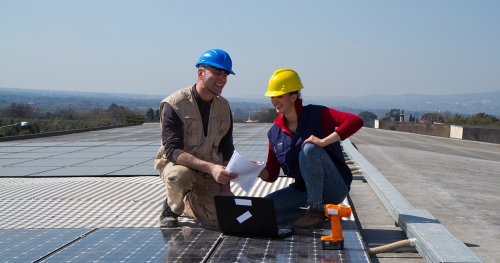Implementation, Impact, and Cost Findings from the New York City P-TECH 9-14 Schools Evaluation
P-TECH 9-14 Evaluation

Overview
The idea for this high school model began in 2010 in New York City when then-Mayor Michael Bloomberg announced a public-private partnership of the New York City Department of Education, the City University of New York, the New York City College of Technology, and IBM to develop a new approach to secondary and postsecondary education. The result was P-TECH High School, which opened in Brooklyn in September 2011. The school provides students with an enriched curriculum that is aligned with actual employment opportunities with industry partner IBM and that enables them to earn both a high school diploma and a cost-free Associate in Applied Science degree in six years. Students have professional mentors, workplace experiences, and internships. Graduates are to be first in line for entry-level job openings at IBM.
Since the first P-TECH Grades 9-14 school opened in 2011, an additional six schools have opened in New York City, all with different sponsoring employers and themes. The model has also proliferated across New York State, nationally, and internationally.
The NYC P-TECH Grades 9-14 high school model is a multifaceted approach that represents a contemporary vision for career and technical education. It is a hybrid model, combining elements of several other models that have produced strong impacts, including New York City’s Small Schools of Choice, Career Academies, and Early College High Schools. By combining academic study with a strong career focus that begins in high school and extends into postsecondary education and the workforce, the model aims to prepare students for college and career ― not one or the other ― which is a different approach to contemporary high school reform. Employer partners support the schools in many ways, primarily by providing work-based learning experiences linked to real career opportunities. In addition, the high schools collaborate with local colleges to provide students with an opportunity to earn a college credential while simultaneously earning a high school diploma.
Additional Project Details
Agenda, Scope, and Goals
A key feature of the NYC P-TECH Grades 9-14 model is the institutional partnership that exists among secondary education, postsecondary education, and industry. This partnership enables students to have a seamless experience in which high school, college, and career training are aligned. It also allows students to graduate with a high school diploma and an associate’s degree (or another industry-accepted two-year credential) in a high-skills, high-demand field.
MDRC is conducting an impact, implementation, and cost study of the NYC P-TECH Grades 9-14 school model, incorporating data from all seven of the New York City schools and a set of comparison schools.
The impact research is designed to answer four main questions:
- What is the effect of being offered a seat in a P-TECH Grades 9-14 school on students’ high school success and college readiness?
- What is the effect of being offered a seat in a P-TECH Grades 9-14 school on postsecondary enrollment, credit accumulation, and degree attainment?
- What is the effect of enrolling in a P-TECH Grades 9-14 school on students’ high school success and college readiness?
- What is the effect of enrolling in a P-TECH Grades 9-14 school on postsecondary enrollment, credit accumulation, and degree attainment?
The implementation research is designed to answer four main questions:
- To what extent are the core components of the model implemented as designed?
- What is the nature, intensity, and duration of programming offered to students and received by students?
- How different are the experiences offered to students in P-TECH Grades 9-14 schools from those offered to students in non-P-TECH Grades 9-14 schools?
- What are the conditions under which P-TECH Grades 9-14 schools are being implemented?
The cost study is designed to answer two questions:
- What are the start-up and ongoing costs associated with the P-TECH Grades 9-14 program?
- How cost-effective is the P-TECH Grades 9-14 model?
Design, Sites, and Data Sources
The impact study will take advantage of New York City’s lottery-based high school admissions process to define sets of students who randomly won and students who lost the opportunity to attend one of the P-TECH Grades 9-14 schools. The study will measure outcomes for multiple cohorts of students enrolled in the schools between the 2011-2012 school year and the 2020-2021 school year. Data for this piece of the study will be collected from the NYC Department of Education, the City University of New York, and the Research Alliance for New York City Schools.
The implementation study is focused on describing and documenting the P-TECH Grades 9-14 model in New York City and understanding how P-TECH schools differ from a set of comparison high schools in New York City. Specifically, it will describe the model’s components as implemented during the study period, will describe what happened in a set of comparison schools, and will help explain the impact findings.
The implementation study will use data collected from surveys, focus groups, and interviews with a variety of stakeholders, including students, staff, and school leaders from the high school and college systems in New York City and from industry partners.
The cost study will be conducted using the “ingredients” method: Cost data will be collected for the P-TECH Grades 9-14 schools and for the comparison schools. The cost study will use a combination of publicly available cost data and other cost data collected from participating partner organizations.
Featured Work
Dual Enrollment Impacts from the Evaluation of New York City’s P-TECH 9-14 Schools









